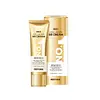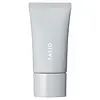What's inside
What's inside
 Key Ingredients
Key Ingredients

 Benefits
Benefits

 Concerns
Concerns

 Ingredients Side-by-side
Ingredients Side-by-side

Water
Skin ConditioningEthylhexyl Methoxycinnamate
UV AbsorberEthylhexyl Salicylate
UV AbsorberButylene Glycol
HumectantZinc Oxide
Cosmetic ColorantTitanium Dioxide
Cosmetic ColorantC12-15 Alkyl Benzoate
AntimicrobialHomosalate
Skin ConditioningBis-Ethylhexyloxyphenol Methoxyphenyl Triazine
Skin ConditioningGlycerin
HumectantButyl Methoxydibenzoylmethane
UV AbsorberNiacinamide
SmoothingPropylene Glycol
HumectantCetyl PEG/PPG-10/1 Dimethicone
EmulsifyingPolyglyceryl-3 Polyricinoleate
EmulsifyingCetyl Dimethicone
EmollientSodium Chloride
MaskingAluminum Hydroxide
EmollientStearic Acid
CleansingSodium Hyaluronate
HumectantMicrocrystalline Wax
Emulsion StabilisingTriethoxycaprylylsilane
Anthemis Nobilis Flower Extract
MaskingHamamelis Virginiana Extract
AntiseborrhoeicAloe Barbadensis Leaf Extract
EmollientCentella Asiatica Extract
CleansingRosa Centifolia Flower Water
Skin ConditioningCamellia Sinensis Leaf Extract
AntimicrobialHydrolyzed Collagen
EmollientSnail Secretion Filtrate
Skin Conditioning1,2-Hexanediol
Skin ConditioningAdenosine
Skin ConditioningPhenoxyethanol
PreservativeCI 77492
Cosmetic ColorantCI 77491
Cosmetic ColorantCI 77499
Cosmetic ColorantParfum
MaskingWater, Ethylhexyl Methoxycinnamate, Ethylhexyl Salicylate, Butylene Glycol, Zinc Oxide, Titanium Dioxide, C12-15 Alkyl Benzoate, Homosalate, Bis-Ethylhexyloxyphenol Methoxyphenyl Triazine, Glycerin, Butyl Methoxydibenzoylmethane, Niacinamide, Propylene Glycol, Cetyl PEG/PPG-10/1 Dimethicone, Polyglyceryl-3 Polyricinoleate, Cetyl Dimethicone, Sodium Chloride, Aluminum Hydroxide, Stearic Acid, Sodium Hyaluronate, Microcrystalline Wax, Triethoxycaprylylsilane, Anthemis Nobilis Flower Extract, Hamamelis Virginiana Extract, Aloe Barbadensis Leaf Extract, Centella Asiatica Extract, Rosa Centifolia Flower Water, Camellia Sinensis Leaf Extract, Hydrolyzed Collagen, Snail Secretion Filtrate, 1,2-Hexanediol, Adenosine, Phenoxyethanol, CI 77492, CI 77491, CI 77499, Parfum
Water
Skin ConditioningCyclomethicone
EmollientEthylhexyl Methacrylate
Methyl Trimethicone
Skin ConditioningEthylhexyl Isononanoate
EmollientPEG-9 Polydimethylsiloxyethyl Dimethicone
EmulsifyingDiethylamino Hydroxybenzoyl Hexyl Benzoate
UV FilterEthylhexyl Palmitate
EmollientBis-Ethylhexyloxyphenol Methoxyphenyl Triazine
Skin ConditioningPolymethylsilsesquioxane
Olea Europaea Fruit Oil
MaskingSesamum Indicum Seed Oil
EmollientCarthamus Tinctorius Seed Oil
MaskingGoat Fat
Skin ConditioningJellyfish Extract
HumectantTocopherol
AntioxidantSimmondsia Chinensis Seed Oil
EmollientLimnanthes Alba Seed Oil
Skin ConditioningButylene Glycol
HumectantBHT
AntioxidantSilica Dimethicone Silylate
AbsorbentHectorite
AbsorbentSodium Stearoyl Glutamate
CleansingCetyl PEG/PPG-10/1 Dimethicone
EmulsifyingMethyl Di-T-Butyl Hydroxyhydrocinnamate
AntioxidantPentaerythritol
HumectantTriethoxycaprylylsilane
Hydrogen Dimethicone
Hydroxyapatite
AbrasivePolyisoprene
Polymethacrylic Acid
Lauryl PEG-9 Polydimethylsiloxyethyl Dimethicone
Skin ConditioningPolyglyceryl-6 Laurate
EmulsifyingLecithin
EmollientSodium Chloride
MaskingPotassium Hydroxide
BufferingHydroxylated Lecithin
EmulsifyingPhenoxyethanol
PreservativeMica
Cosmetic ColorantTitanium Dioxide
Cosmetic ColorantZinc Oxide
Cosmetic ColorantCI 77492
Cosmetic ColorantWater, Cyclomethicone, Ethylhexyl Methacrylate, Methyl Trimethicone, Ethylhexyl Isononanoate, PEG-9 Polydimethylsiloxyethyl Dimethicone, Diethylamino Hydroxybenzoyl Hexyl Benzoate, Ethylhexyl Palmitate, Bis-Ethylhexyloxyphenol Methoxyphenyl Triazine, Polymethylsilsesquioxane, Olea Europaea Fruit Oil, Sesamum Indicum Seed Oil, Carthamus Tinctorius Seed Oil, Goat Fat, Jellyfish Extract, Tocopherol, Simmondsia Chinensis Seed Oil, Limnanthes Alba Seed Oil, Butylene Glycol, BHT, Silica Dimethicone Silylate, Hectorite, Sodium Stearoyl Glutamate, Cetyl PEG/PPG-10/1 Dimethicone, Methyl Di-T-Butyl Hydroxyhydrocinnamate, Pentaerythritol, Triethoxycaprylylsilane, Hydrogen Dimethicone, Hydroxyapatite, Polyisoprene, Polymethacrylic Acid, Lauryl PEG-9 Polydimethylsiloxyethyl Dimethicone, Polyglyceryl-6 Laurate, Lecithin, Sodium Chloride, Potassium Hydroxide, Hydroxylated Lecithin, Phenoxyethanol, Mica, Titanium Dioxide, Zinc Oxide, CI 77492
 Reviews
Reviews

Ingredients Explained
These ingredients are found in both products.
Ingredients higher up in an ingredient list are typically present in a larger amount.
You might know this ingredient as Tinosorb S or Bemotrizinol. It is a UV filter that covers both UVA and UVB rays.
This ingredient has two peak UV absorption peaks ( 310 and 340 nm) and is able to absorb both UV-A and UV-B rays. This ingredient works by preventing UV rays from reaching and damaging your skin.
On top of that - it is highly photostable and helps prevent the photodegration of other sunscreen ingredients such as avobenzone.
Tinosorb S is allowed in the EU, Australia, and Asia. It is close to being approved by the FDA and we'll hopefully get this ingredient in the U.S. by late 2025.
Fun fact: Tinosorb S is the most effective UV absorber at maximum concentration (measured by SPF) permitted in the EU.
This ingredient is oil-soluble, so your oil-cleansers will take this right off at night.
Learn more about Bis-Ethylhexyloxyphenol Methoxyphenyl TriazineButylene Glycol (or BG) is used within cosmetic products for a few different reasons:
Overall, Butylene Glycol is a safe and well-rounded ingredient that works well with other ingredients.
Though this ingredient works well with most skin types, some people with sensitive skin may experience a reaction such as allergic rashes, closed comedones, or itchiness.
Learn more about Butylene GlycolThis ingredient is a high molecular weight silicone. It has emulsifying and skin conditioning properties.
Ci 77492 is also hydrated iron III oxide. It's sole purpose is to give a yellow hue to products.
Iron III oxides are classified as inorganic chemicals for coloring.
Synthetically created Ci 77492 is considered safer than those naturally found. This is because the synthetically created version may contain less impurities. Iron oxides are generally non-toxic and non-allergenic.
Learn more about CI 77492Phenoxyethanol is a preservative that has germicide, antimicrobial, and aromatic properties. Studies show that phenoxyethanol can prevent microbial growth. By itself, it has a scent that is similar to that of a rose.
It's often used in formulations along with Caprylyl Glycol to preserve the shelf life of products.
Chances are, you eat sodium chloride every day. Sodium Chloride is also known as table salt.
This ingredient has many purposes in skincare: thickener, emulsifier, and exfoliator.
You'll most likely find this ingredient in cleansers where it is used to create a gel-like texture. As an emulsifier, it also prevents ingredients from separating.
There is much debate on whether this ingredient is comedogenic. The short answer - comedogenic ratings don't tell the whole story. Learn more about comegodenic ratings here.
The concensus about this ingredient causing acne seems to be divided. Research is needed to understand if this ingredient does cause acne.
Scrubs may use salt as the primary exfoliating ingredient.
Learn more about Sodium ChlorideTitanium dioxide is a mineral UV filter widely used in sunscreens and cosmetics.
It is one of only two UV filters officially classified as “mineral” by regulatory agencies, the other being zinc oxide.
Titanium dioxide provides broad-spectrum protection mostly in the UVB and UVAII range, with some protection in the UVAI range.
While its UVA protection isn’t as strong as zinc oxide’s, the difference is minor.
A common myth is that mineral UV filters reflect UV light. However, modern research shows titanium dioxide absorbs UV radiation like chemical filters (~95% absorption & 5% reflection).
Thanks to its non-irritating nature, titanium dioxide is suitable for sensitive, acne-prone, or redness-prone skin. It is unlikely to cause "eye sting" like other sunscreen ingredients.
A major drawback of this ingredient is its white cast and thick texture. This is why mineral sunscreens often leave a white cast and are less cosmetically elegant than chemical/hybrid sunscreens.
To improve white cast and spreadability, micronized or nano-sized titanium dioxide is often used.
There are ongoing concerns surrounding nano-titanium oxide's impact on marine ecosystems.
There is no conclusive evidence that any form of titanium oxide (or any other sunscreen ingredients) will cause harm to marine ecosystems or coral reefs. The science is still developing but many consumers are keeping a close eye on this issue.
Please note, many destinations have reef-safety sunscreen rules. For instance, the U.S. Virgin Islands advises all visitors to use non-nano mineral sunscreens.
Nano mineral sunscreens once raised safety concerns about absorption into skin.
Extensive research has shown that they do not penetrate healthy or damaged skin; they remain safely on the surface and the top layer of dead skin (stratum corneum).
You'll likely find titanium dioxide bundled with alumina, silica, or dimethicone. These ingredients help make titanium dioxide highly photostable; this prevents it from interacting with other formula components under UV light.
Learn more about Titanium DioxideTriethoxycaprylylsilane is a silicone used to bind and stabilize ingredients.
As an emulsifier, it helps prevent ingredients from separating. This can help elongate the shelf life of products.
Triethoxycaprylylsilane is often used to coat mineral sunscreens ingredients to help give a better feel. It also helps reduce oxidative stress in sunscreens.
Learn more about TriethoxycaprylylsilaneWater. It's the most common cosmetic ingredient of all. You'll usually see it at the top of ingredient lists, meaning that it makes up the largest part of the product.
So why is it so popular? Water most often acts as a solvent - this means that it helps dissolve other ingredients into the formulation.
You'll also recognize water as that liquid we all need to stay alive. If you see this, drink a glass of water. Stay hydrated!
Learn more about WaterZinc Oxide is a mineral broad-spectrum UV filter; it is the broadest UVA and UVB reflector approved by the FDA. It also has skin protectant and skin soothing properties.
Zinc oxide is one of the most effective broad-spectrum UV filters. It protects against UVB, UVAII, and UVAI. In comparison to its counterpart titanium dioxide, zinc oxide provides uniform and extended UVA protection.
Another great benefit? This ingredient is highly photostable so it won't degrade easily under sunlight.
A common myth is that mineral UV filters are widely believed to primarily reflect UV light.
However, modern research shows titanium dioxide absorbs UV radiation like chemical filters (~95% absorption & 5% reflection).
Zinc oxide has great skin soothing properties so you'll likely find this in sunscreens formulated for sensitive skin or babies/children. It is unlikely to cause "eye sting" like other sunscreen ingredients.
Regulatory agencies consider zinc oxide to be non-toxic and safe. It has also been shown to not penetrate the skin.
Unfortunately, this ingredient does leave a visible white cast. This is why mineral sunscreens are often less cosmetically elegant than chemical or hybrid ones.
In cosmetics, zinc oxide can be found in both non-nano and nano-sized forms. The nano version is used to reduce white cast and improve the texture of sunscreen formulas.
There are ongoing concerns surrounding nano-zinc oxide's impact on marine ecosystems and whether it can be absorbed into skin.
Regarding marine ecosystems and coral reefs, there is no conclusive evidence that any form of zinc oxide (or any other sunscreen ingredients) will cause harm. The science is still developing but many consumers are keeping a close eye on this issue.
Please note, many destinations have reef-safety sunscreen rules. For instance, the U.S. Virgin Islands advises all visitors to use non-nano mineral sunscreens.
There has also been some stir about whether micronized or nano zinc oxide has potential photoxicity and absorption through the skin/lungs.
An in-vitro (done in a test tube or petri dish) study demonstrated micronized zinc oxide to have potential phototoxicity. There's no need to fret; the EU Commission's Scientific Committee on Consumer Safety has stated, "The relevance of these findings needs to be clarified by appropriate investigations in vivo." Or in other words, further studies done on living organisms are needed to prove this.
Current research shows zinc oxide nanoparticles do not penetrate intact or sunburned skin. They either remain on the surface or in the outermost layer of dead skin (stratum corneum).
Zinc oxide is one of only two classified mineral UV filters with titanium dioxide being the other one.
Fun fact: Zinc has been used throughout history as an ingredient in paint and medicine. An Indian text from 500BC is believed to list zinc oxide as a salve for open wound. The Ancient Greek physician Dioscorides has also mentioned the use of zinc as an ointment in 1AD.
Learn more about Zinc Oxide